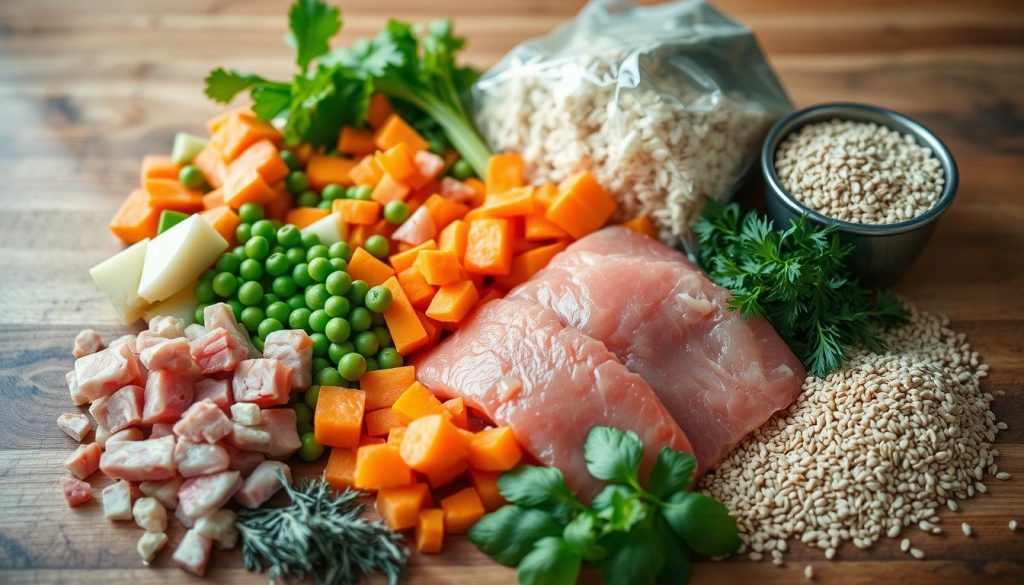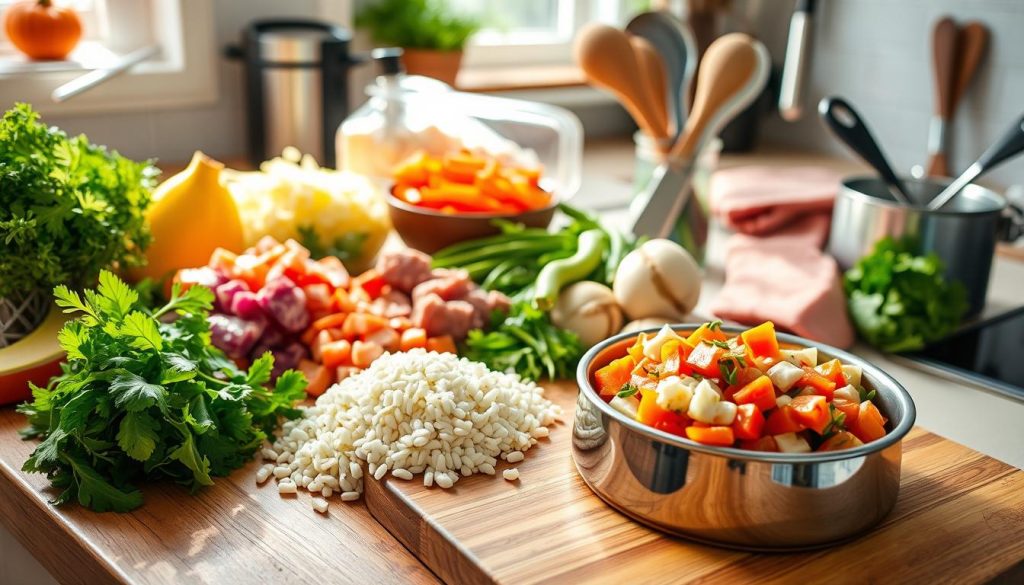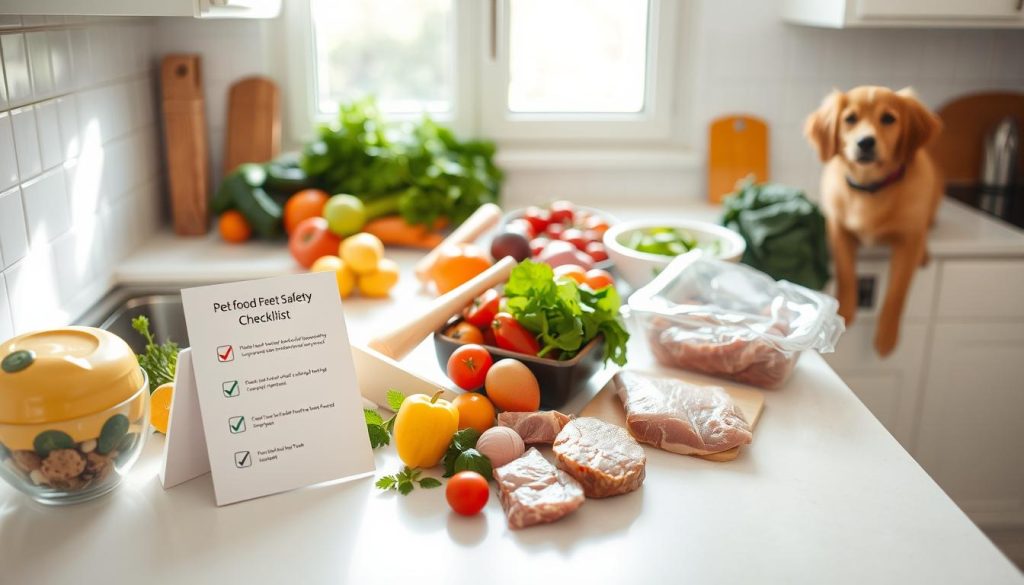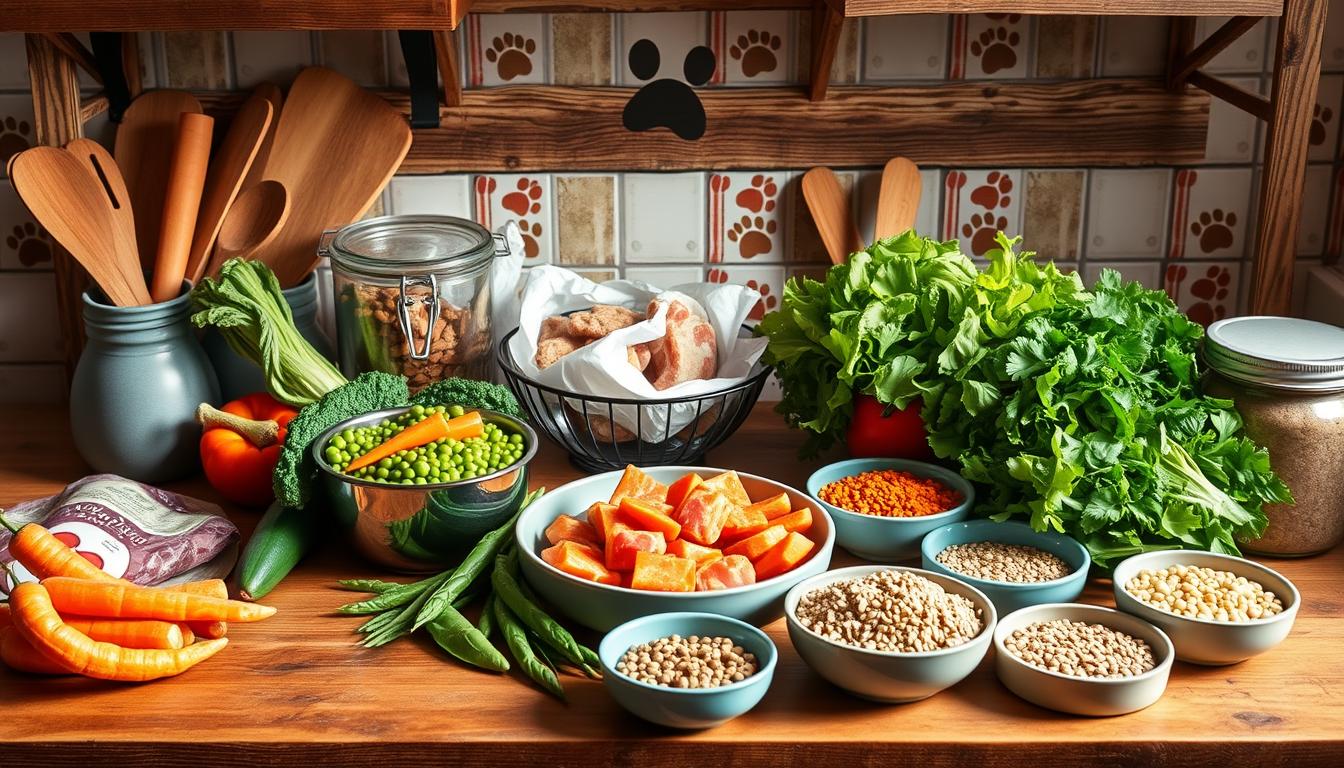I’ve always wanted the best for my pets. That’s why I started making their food at home. It’s cheaper and lets me pick the ingredients. This way, my pets get fresh, healthy food.
In this article, I’ll share my experiences with homemade pet food. I’ll talk about its benefits, clear up myths, and give you tasty recipes. These recipes are sure to please your dogs and cats. This guide will help you switch to homemade food for better health, savings, or more control over their diet.
Let’s dive into natural pet nutrition together. Discover how homemade food can make your pets’ lives better.
Why I Choose to Make Homemade Pet Food
As a devoted pet parent, my pets’ health and well-being are my top priorities. That’s why I choose to make homemade pet food for my dogs and cats. There are many reasons why I prefer this over commercial pet food.
Benefits of Homemade Pet Food
One big advantage of homemade pet food is controlling the quality and freshness of ingredients. I pick high-quality, human-grade proteins, vegetables, and other wholesome components. This ensures my pets get the best nutrition and avoids questionable additives or fillers.
Common Myths About Homemade Pet Food
Despite its benefits, there are myths about homemade pet food. Some think it’s hard to prepare, but it’s simple with the right recipes. Another myth is it’s less nutritious than commercial food, but it can be more nutritious and tailored to your pet’s needs.
Cost Comparison: Homemade vs. Store-Bought
Switching to homemade food is a cost-effective surprise for many pet owners. While initial ingredient costs may be higher, long-term savings are significant. By avoiding commercial food markups, I save money and provide healthier meals for my pets.
Overall, making homemade pet food has been a game-changer for my pets and my wallet. It’s a choice I’m proud to make and recommend to any pet parent wanting to improve their furry friend’s health and well-being.
Essential Ingredients for Pet Nutrition

As a pet owner, I know how important a good diet is for my furry friends. Homemade pet food needs the right ingredients for health and happiness. Let’s look at what’s key.
Proteins: What My Pets Need
Protein is vital for pets. It helps with muscle, skin, and coat health, and supports the body. I use high-quality proteins like chicken, beef, or fish. I also mix different proteins to meet my pets’ needs and tastes.
Vegetables: The Best Choices for Health
- Carrots: Rich in beta-carotene, which supports eye health and immune function.
- Spinach: Packed with vitamins and minerals, including iron and calcium.
- Sweet potatoes: A great source of fiber and antioxidants, helping to maintain digestive health.
I pick and add various veggies to my pets’ food. This ensures they get the vitamins, minerals, and fiber they need for health.
Grains and Carbs: Are They Necessary?
Grains and carbs are not needed by all pets. But, they can give energy and fiber. I choose whole grains like brown rice or oats for more nutrition. I also consider my pets’ needs and might choose grain-free options if needed.
Supplements: When to Use Them
At times, I add extra nutrients like omega-3 fatty acids, probiotics, or joint support. This is especially true for pets with health issues. I always talk to my vet before adding any supplements.
Knowing the right ingredients helps me make meals that are tasty and healthy for my pets. It’s a fulfilling way to care for them.
Simple Homemade Pet Food Recipes

Preparing meals for our furry friends at home is rewarding. I’ll share three easy, nutritious recipes for cats and dogs. These recipes are budget-friendly and let you control the ingredients, ensuring your pets get the best nutrition.
Dog-Friendly Chicken and Rice
This classic dish is a hit with dogs. Start by sautéing boneless, skinless chicken breasts in olive oil until cooked. Then, add brown rice and low-sodium chicken broth, simmering until the rice is tender.
For extra nutrients, add steamed broccoli or carrots. Your dog will love this mix of protein, carbs, and veggies.
Nutritious Beef and Veggie Mix
This recipe is great for both cats and dogs, offering a balanced mix of nutrients. Brown ground beef in a pan, then add diced sweet potatoes, green beans, and low-sodium beef broth. Simmer until the veggies are tender.
You’ll have a wholesome, easy pet food recipe that your furry friends will enjoy.
Grain-Free Salmon Delight
This salmon-based recipe is perfect for pets sensitive to grains. Bake or poach fresh salmon fillets, then flake the meat. Mix it with mashed sweet potatoes and a bit of coconut oil.
This grain-free dish is full of omega-3 fatty acids, protein, and essential nutrients. It supports your pet’s health and well-being.
Always talk to your vet before changing your pet’s diet. They can guide you on your pet’s nutritional needs. Enjoy these simple homemade pet food recipes and watch your pets thrive!
Food Safety Tips for Homemade Pet Food

Making homemade pet food is a great way to keep your pets healthy. But, it’s important to keep their food safe. Here are some key tips to make sure their food stays healthy and safe.
Proper Handling and Storage
Good hygiene is key when making pet food. Wash your hands well, clean all surfaces and tools, and handle raw ingredients carefully. It’s also important to store the food right. Keep it in the fridge or freezer and use tight containers to stop contamination. Always follow the storage times for each ingredient.
Avoiding Harmful Ingredients
- Don’t use raw meat, eggs, or unpasteurized dairy because they can have harmful bacteria like Salmonella or E. coli.
- Stay away from onions, garlic, grapes, raisins, and xylitol because they’re toxic to pets.
- Try to use high-quality, organic ingredients for pet food to lower the risk of pet food safety problems.
FAQs about Food Safety
- How long can homemade pet food be stored? It depends on the ingredients, but usually, it lasts 3-5 days in the fridge and 2-3 months in the freezer.
- Can I reheat homemade pet food? Yes, but make sure it’s hot enough to kill bacteria.
- Are there any special considerations for organic pet meals? Organic foods might spoil faster, so check expiration dates and storage times closely.
By following these safety tips, you can make tasty and pet food safety homemade meals for your pets. Making sure to handle and store the food properly will help your pets enjoy a healthy, homemade diet.
Transitioning Your Pet to Homemade Food
Changing your pet’s diet to homemade can be big, but it can also be smooth. As someone who cares about natural pet nutrition, I’ve found that slow introduction and watching closely are crucial. This helps your pet adjust well to a raw pet food diet.
How to Introduce New Food Gradually
Start slow when switching your pet to homemade food. Mix a little of the new food with their old diet. Gradually add more of the new food over 7-10 days. This helps their body get used to the new food and flavors, avoiding upset stomachs.
Signs My Pet Is Adjusting Well
- Increased energy and activity levels
- Healthy, shiny coat and skin
- Consistent, well-formed stools
- Enthusiasm for mealtime
Troubleshooting Transition Issues
Even with careful planning, your pet might face some challenges. If they show signs of upset stomach, like vomiting or diarrhea, slow down the change. Talk to your vet for advice. They can help fix any issues and make sure your pet’s diet change goes smoothly.
Changing your pet’s diet to homemade takes time and patience. But the benefits are huge. By following these steps and watching your pet’s health, you can make a successful switch to a healthier diet for them.
Resources for Homemade Pet Food
Many pet owners want to try homemade pet food. There are lots of resources to help you. You can find recipes, nutrition advice, and a community to support you.
Recommended Cookbooks and Websites
Start with cookbooks like “The Healthy Homemade Pet Food Cookbook” by Carol Jones or “DIY Dog Food” by Becker & Rosenfeld. They have tasty, healthy recipes for your pet. Websites like Petmd.com and DogFoodAdvisor.com also have great info on food choices and safety.
Pet Nutrition Courses and Webinars
Learn more about homemade pet food with online courses or webinars. The Pet Nutrition Alliance and the American College of Veterinary Nutrition offer these. They teach about dog and cat nutrition, helping you choose the best food for your pet.
Online Communities for Support
Joining online forums or Facebook groups is helpful. They’re for people who make their pet food at home. You can share tips, ask questions, and get advice from others who know what you’re going through.

